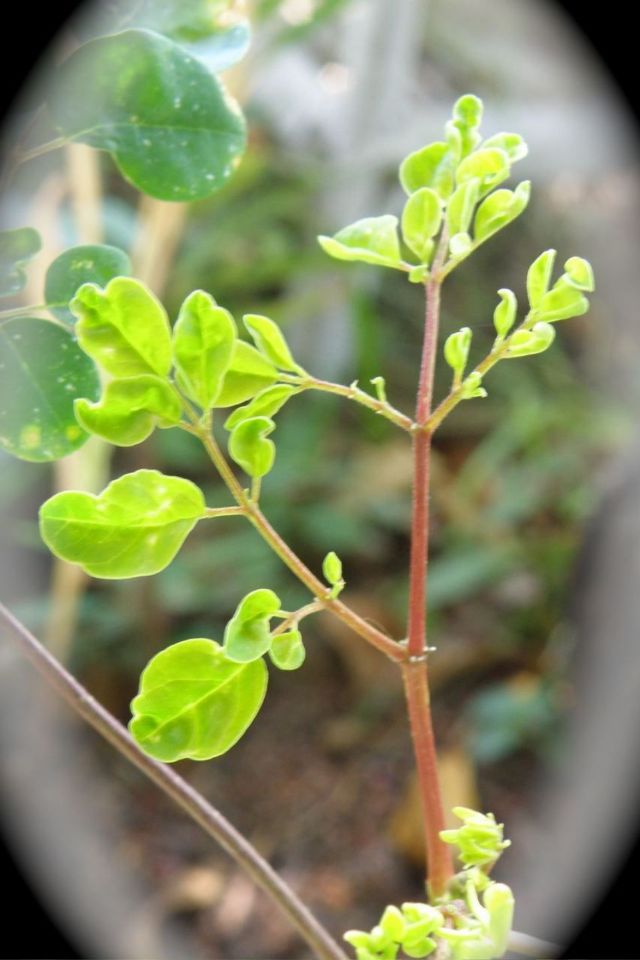Maringa Trees for 300 Diseases by YourEnchantedGardener .....
Growing a Maringa Tree Poster plus info.
Date: 6/25/2009 1:02:33 PM ( 15 y ago)
AMAZING USE
TO CLARIFY MUDDY WATER!!!!!
Seeds crushed to a powder are used to clarify turbid, dirty water. The cleansing takes place by a process of electrical charges established between the muddy particles suspended in the water and the pulverised seeds, and gradually, after about an hour, the muddy particles are pulled to the bottom of the water by the force of gravity. Research shows that the seed not only settles the mud, but can carry with it over 90% of bacteria and viruses. A report published in New Scientist, December 1983, said that the seeds have been used in Sudan and Peru to purify muddy river water. It was also reported that seeds have antimicrobial activity. The seeds also have potential for treating sewerage water.

New growth!
Maringa Tree, planted in a pot
June 21, 09 here at
THE ENCHANTED GARDEN INTENTIONAL COMMUNITY
I got this from DR. W. JOHN MARTIN, MD
who asked for my help for a project called
GREEN HOPE USA.
11:01 AM
June 25, 09
Maringa Trees for 300 Diseases

http://www.treesforlife.org/our-work/our-initiatives/moringa/moringa-tree
FIRST INTRO TO MARINGA TREES:
http://curezone.com/blogs/fm.asp?i=971635
EXCELLENT ARTICLE ON THIS TREE:
http://www.permacultureusa.org/2009/04/11/drumstick-tree/#more-913
USES:
Medicinal uses:
A folk remedy for stomach complaints, catarrh, hay fever, impotence, edema, cramps, hemorrhoids, headaches, sore gums; to strengthen the eyes and the brain, liver, gall, digestive, respiratory and immune system, as a blood cleanser and blood builder, and for cancer treatment. A traditional folk remedy was to use the leaves as a poultice on the abdomen to expel intestinal worms. Oil from the seed, called Oil of Ben, is used for earache and in ointments for skin conditions. The oil rubbed on the skin is said to prevent mosquitoes from biting. Flowers infused in honey are used as a cough remedy.
Culinary uses:
Research has shown the drumstick tree to be of exceptional nutritional value. The leaves are 38% protein with all essential amino acids, which will be of interest to vegetarians, or people who wish to cut back on meat and dairy products, or regions where protein is lacking. On a recent ‘Good Medicine’ TV program filmed in Africa, drumstick trees were grown in close rows, regularly cut when growth was 1 metre high, and the leaves dried and crushed. Two tablespoons of the high protein powder was given in the daily diet, to help overcome malnutrition.
Amino acids in green leaf vegetables vary considerably, and many that are staples are low in the sulphur-bearing amino acids methionine and cystine, whereas in the drumstick tree it is an extremely rich source in comparison to other greens and vegetables. The drumstick tree is listed as having the highest protein ratio of any plant on earth. The calcium content is very high at 297mg per 100g of leaves.
Leaves can be eaten fresh in hand, steamed, pickled, added to salads, stir-fries, curries, and soups. Leaves can be dried, and stored, for using in cooked dishes as required. Flavour of the pods are similar to peas with a mild mustard taste. Sliced, young green pods can be used in savory and meat dishes. Seeds can be fried or roasted and taste like peanuts. When seeds are abundant they can be sprouted like wheat grass, eaten as tender nutritious greens.
Roots of young seedlings taste similar to the herb horseradish, and are often grated and used as a substitute. Oil of Ben, a by-product of the seed, is an inodorous fine-grade oil used in salads, cooking, perfumery, lubricating watches and fine machinery. The oil does not go rancid. Flowers can be eaten or used as a garnish, and look most decorative in salads. Value the tree for its high nutritional value and as a survival food.
Other uses:
AMAZING USE
TO CLARIFY MUDDY WATER!!!!!
Seeds crushed to a powder are used to clarify turbid, dirty water. The cleansing takes place by a process of electrical charges established between the muddy particles suspended in the water and the pulverised seeds, and gradually, after about an hour, the muddy particles are pulled to the bottom of the water by the force of gravity. Research shows that the seed not only settles the mud, but can carry with it over 90% of bacteria and viruses. A report published in New Scientist, December 1983, said that the seeds have been used in Sudan and Peru to purify muddy river water. It was also reported that seeds have antimicrobial activity. The seeds also have potential for treating sewerage water.
LIVING WATER SYSTEMS
JEFF LOUIS BROUGHT THIS TO MY
ATTENTION AT LIVE H20 LONG BEACH BELMONT SHORES:
http://curezone.com/blogs/fm.asp?i=1447372
Popularity: message viewed 21568 times
URL: http://www.curezone.org/blogs/fm.asp?i=1444124
<< Return to the standard message view
Page generated on: 11/7/2024 5:03:55 PM in Dallas, Texas
www.curezone.org